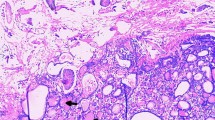Abstract
Background: Struma ovarii is the most common monodermal ovarian teratoma and consists mainly of thyroid tissue. Only 5% of patients with this tumor have features of hyperthyroidism. The pathophysiology of hyperthyroidism in struma ovarii is not clear. Case: We describe a case of benign struma ovarii, presenting with the clinical features of an ovarian cancer: large complex pelvic mass, large amount of ascites and markedly elevated CA-125 serum levels. The patient was initially treated for Graves’ disease, on the basis of ultrasonographic, laboratoristic and scintigraphic evidence. The resistance to the medical treatment led to thyroidectomy. After surgery the hyperthyroidism persisted and, suddenly, the patient presented ascites. A large pelvic mass was then diagnosed which, at the pathologic examination, was diagnosed as a struma ovarii. Conclusion: The struma ovarii always has to be considered when a pelvic mass is associated with features of hyperthyroidism.
Similar content being viewed by others
References
Bethune M, Quinn M, Rome R. Struma ovarii presenting as acute pseudo-Meigs syndrome with an elevated CA 125 level. Aust N Z J Obstet Gynaecol 1996, 36: 372–3.
Thomas RD, Batty VB. Metastatic malignant struma ovarii. Two case reports. Clin Nucl Med 1992, 17: 577–8.
Rosenblum NG, LiVolsi VA, Edmonds PR, Mikuta JJ. Malignant struma ovarii. Gynecol Oncol 1989, 32: 224–7.
Amr SS, Hassan AA. Struma ovarii with pseudo-Meigs’syndrome. Eur J Obstet Gynecol Reprod Biol 1994, 55: 205–8.
Ciccarelli A, Valdes-Socin H, Parma J, et al. Thyrotoxic adenoma followed by atypical hyperthyroidism due to struma ovarii: clinical and genetic studies. Eur J Endocrinol 2004, 150: 431–7.
Kung AWC, Ma JTC, Wang C, Young RTT. Hyperthyroidism during pregnancy due to coexistence of struma ovarii and Graves’disease. Postgrad Med J 1990, 66: 132–3.
Ropars A, Takorabet L, Marion S, Charrerire J. One Monoclonal antibody to human thyrotropin (TSH) receptor agonist of TSH hormone stimulates the proliferation of human thyroid cells. Cell Immunol 1995, 161: 262–9.
Wilders-Truschnig MM, Drexhage HA, Leb G, et al. Chromatoghaphically purified immunoglobulin G of endemic and sporadic goiter patients stimulates FRTL5 cell growth in a mitotic arrest assay. J Clin Endocrinol Metab 1990, 70: 444–52.
Timmerman D, Moerman P, Vergote I. Meigs’ syndrome with elevated serum CA 125 levels: two case report and review of the literature. Gynecol Oncol 1995, 59: 405–8.
Szyfelbein YM, Young RH, Scully RE. Struma ovarii simulating ovarian tumours of other types. A report of 30 cases. Am JSurgPathol 1995, 19: 21–9.
Huh JJ, Montz FJ, Bristow RE. Struma ovarii associated with pseudo-Meigs’ syndrome and elevated serum CA 125. Gynecol Oncol 2002, 86: 231–4.
Author information
Authors and Affiliations
Corresponding author
Rights and permissions
About this article
Cite this article
Guida, M., Mandato, V.D., Di Spiezio Sardo, A. et al. Coexistence of Graves’ disease and benign struma ovarii in a patient with marked ascites and elevated CA-125 levels. J Endocrinol Invest 28, 827–830 (2005). https://doi.org/10.1007/BF03347575
Accepted:
Published:
Issue Date:
DOI: https://doi.org/10.1007/BF03347575




